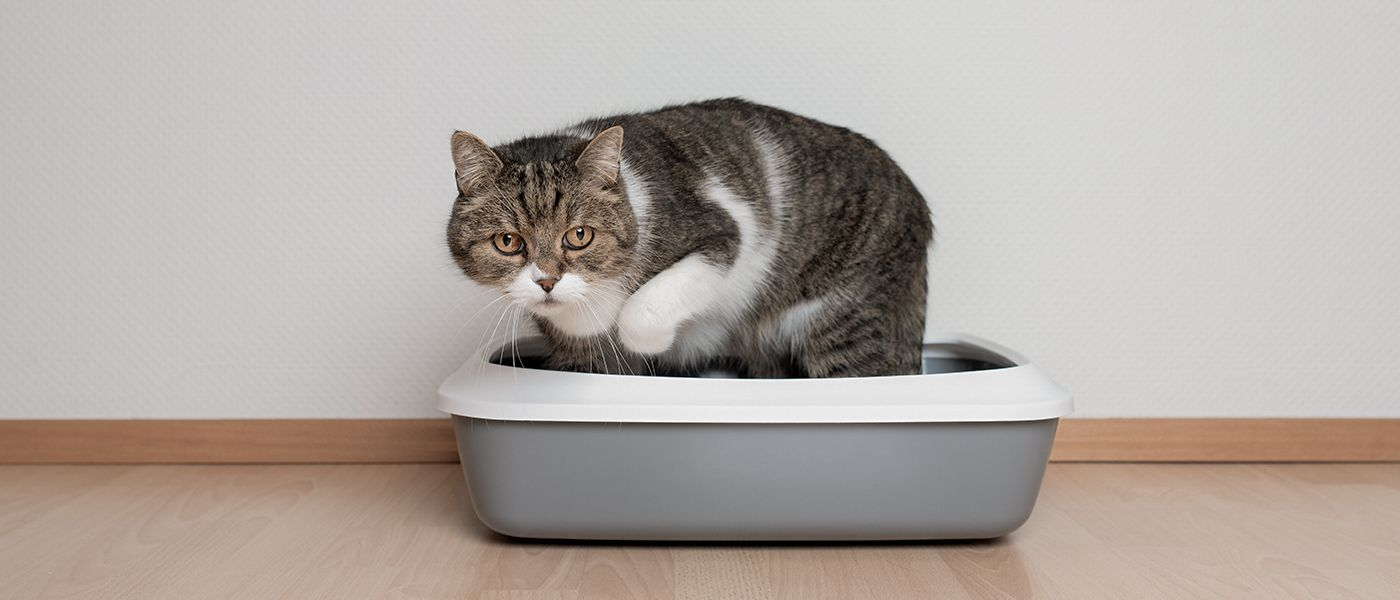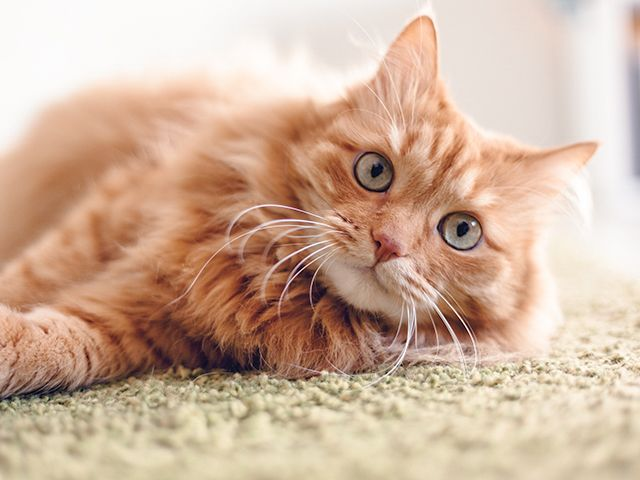Blood in Cat Urine
Article

Bloody urine, also known as hematuria, is a clinical sign associated with several health conditions. In some situations, blood in cat urine can indicate a very serious underlying health issue, while other cases may be quickly resolved with veterinary help.
One of the most common causes of blood in cat urine is Feline Lower Urinary Tract Disease (FLUTD). This term is used to describe a range of conditions that may affect a cat’s bladder and urethra, including cystitis, bladder stones, and urinary tract infections.

How Can I Spot the Signs of Cat Urinary Problems?
The clinical signs of FLUTD vary. Some cats will show no visible signs of illness, while others may display multiple symptoms which worsen over time. This can make detecting cat bladder problems difficult until the problems become severe.Typical clinical signs of FLUTD include:
- Hematuria. In some cases, you may notice drops of blood or discolored urine in your cat’s litter box or about your home. On other occasions, there may be nothing visible, and the blood will only be detectable when your cat’s urine is examined under a microscope by a vet or by using a hematuria kit to test your cat’s urine in their litter box at home.
- Straining in the Litter Box. It’s normal for cats to squat and dig about in the litter box. But if you notice your cat spending more and more time in the litter box, or crouching for extended periods, it may signal inflammation of the urinary tract, a urinary obstruction, or that they feel a greater need to pee.
- Increased Frequency of Urination. If your cat is experiencing a heightened urge to pee, they’ll probably be experiencing discomfort. You may see them making frequent trips to the litter box and peeing increasingly small amounts.
- Inappropriate Urination. Urinating outside the litter box is usually a sign that your cat is feeling stressed, that they dislike or can’t use their litter box, or that they have a medical issue like FLUTD. Cats will sometimes link the pain they feel when they pee with the litter box itself, which may lead to them going elsewhere. Other times, a cat may simply not be able to reach the litter box in time.
- Vocalizing During Urination. If it hurts to pee, your cat may cry out when they urinate. While other cats may attempt to “clean the pain away”, by constantly grooming their genitals.
- Behavioral Changes. A sudden change in behavior may indicate a problem. If your cat is normally content, but now seems anxious, frightened, aggressive, or is hiding from you, it might be a sign that they’re in pain.
If you spot signs of a bladder problem, speak to your vet. Obstructions that prevent a cat from peeing normally are classed as a medical emergency, and serious problems can occur within hours, so you must contact your vet immediately.
Why Is My Cat Peeing Blood?
Many conditions can cause blood to appear in a cat’s pee. Sometimes it may result from an infection, while in other cases it’s linked to inflammation or a physical injury.
Looking at the conditions that fall under FLUTD, there are several that can cause bloody urine, including:
- Bladder Stones. As these mineral formations pass through the bladder, they damage and inflame the tissue, which may lead to blood in a cat’s pee. Stones vary in size and type, but in the most severe cases, they can lead to obstructions that either partially or completely stop a cat from peeing.
- Urinary Tract Infection (UTI). When bacteria accumulate in the urethra and/or bladder, they cause inflammation, which can lead to blood leaking into a cat’s urine.
- Urethral Plugs. This condition arises when an accumulation of waste products prevents the cat from peeing. Blood in the urine is one of the typical clinical signs.
- Feline Idiopathic Cystitis (FIC). This disease can only be diagnosed once all other causes of urinary illness have been excluded. It is thought that stress may play a part in a cat’s susceptibility to FIC.
For further details, see FLUTD Signs, Causes, and Treatment.
My Cat is Peeing Blood: Diagnosing the Issue
Your vet will check the patient history, ask you questions, conduct tests, and make a thorough examination of your cat to discover if their symptoms are the result of a bladder problem like FLUTD or another underlying condition.
These tests may include taking urine and blood samples or performing an x-ray or ultrasound of your cat’s bladder.
It’s important for urine samples to be sterile to get an accurate result if urinary tract infection is a possibility. For this reason, you probably won’t be asked to take a sample from your cat at home. However, in some cases, your vet may suggest using a hematuria detection kit or collecting a urine sample at home if it is difficult to obtain a sample in the clinic.
Hematuria (blood in urine) detection kits contain special color-changing granules that transform in the presence of blood. Even microscopic amounts of blood can trigger a color change, making them a simple way to test your cat’s urine at home. To use, you simply add the granules to your cat’s litter and observe the results after they pee. You can learn more about the Royal Canin Hematuria Detection monitoring tool here.
If a color change occurs, blood is present, and this is a clear sign that a medical issue is present and additional diagnosis and treatment advice from your veterinarian is needed.

Care and Management Options When Your Cat Is Peeing Blood
The treatment your vet recommends will be based on the cause of your cat’s condition. Because multiple illnesses may cause blood to appear in a cat’s urine, there are many possible treatments a vet may suggest. However, some of the more common treatments for FLUTD include:
- Medication. Pain medications, antispasmodics, and anti-inflammatories are often recommended for cats with FLUTD. Antibiotics will only be recommended if a urinary tract infection is present.
- Surgery. If a cat is being prevented from peeing by an obstruction like a bladder stone or a urethral plug, then surgery or catheterization may be needed to clear the blockage.
- Change in Diet. If a cat has a certain type of bladder stone (pure struvite stones), a vet may suggest a new diet to try to dissolve the stones and reduce the probability of a reoccurrence. They may also recommend transitioning to wet food to increase water intake. Some veterinary-exclusive diets contain nutrients that can help support cats experiencing stress. These calming nutrients may be recommended if stress is thought to be a significant factor in your cat's urinary issues.
Support Your Cat's Urinary Health
Treatments like the ones listed above may help improve a cat’s condition, but there’s always a possibility that FLUTD will return. There are, however, some simple changes that you can make to improve your cat’s general urinary health and support their recovery.
- Keep Your Cat Hydrated. Dehydration is known to be a contributing factor to urinary illnesses. Learn more about why your cat should be drinking plenty of water and how you can encourage them to stay hydrated.
- Avoid Stress. Stress is known to play a part in urinary illnesses and is particularly relevant to cats who suffer from FIC and are prone to abnormal stress responses. Read more on how you can take steps to limit your cat’s exposure to stress factors when managing urinary conditions.
- Enrich their Environment. Your cat should enjoy spending time in your home. By making their space feel fun, safe, and comfortable, you can help manage their stress and reduce boredom. Read more on how you can introduce new and engaging enrichment activities in Why Is My Cat Peeing Everywhere?
- Review their Nutrition. While medication is often used to treat the immediate problems associated with FLUTD, a vet may recommend a change in diet as part of a cat’s long-term treatment plan. Your vet can help you choose the most appropriate diet for your cat, based on their breed, age, weight, and health condition.
If you’d like more information, see managing and treating urinary illnesses.
Related Articles
Like & share this page